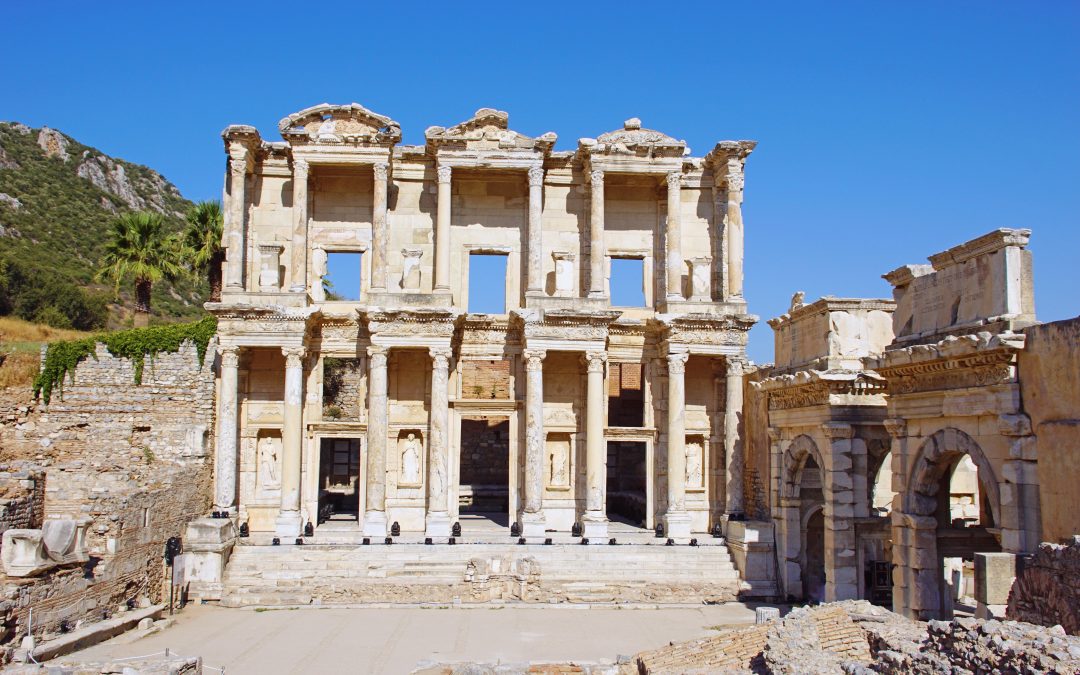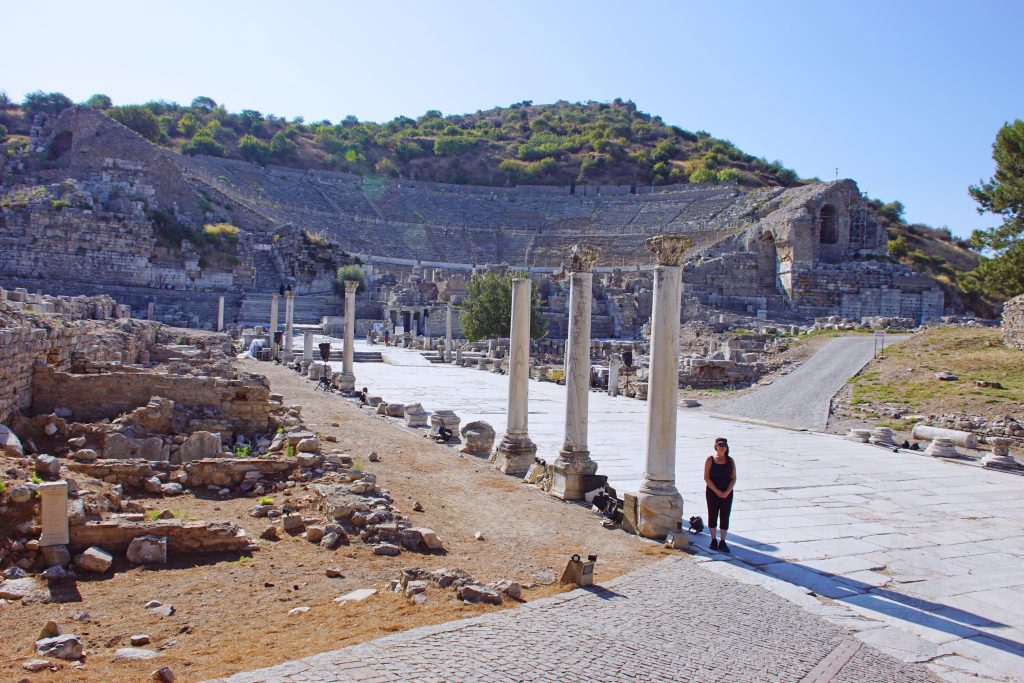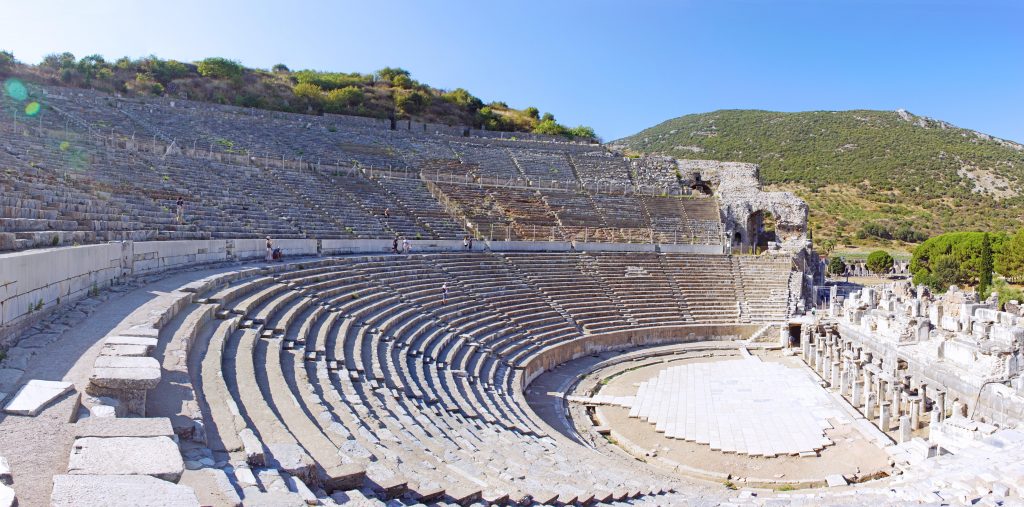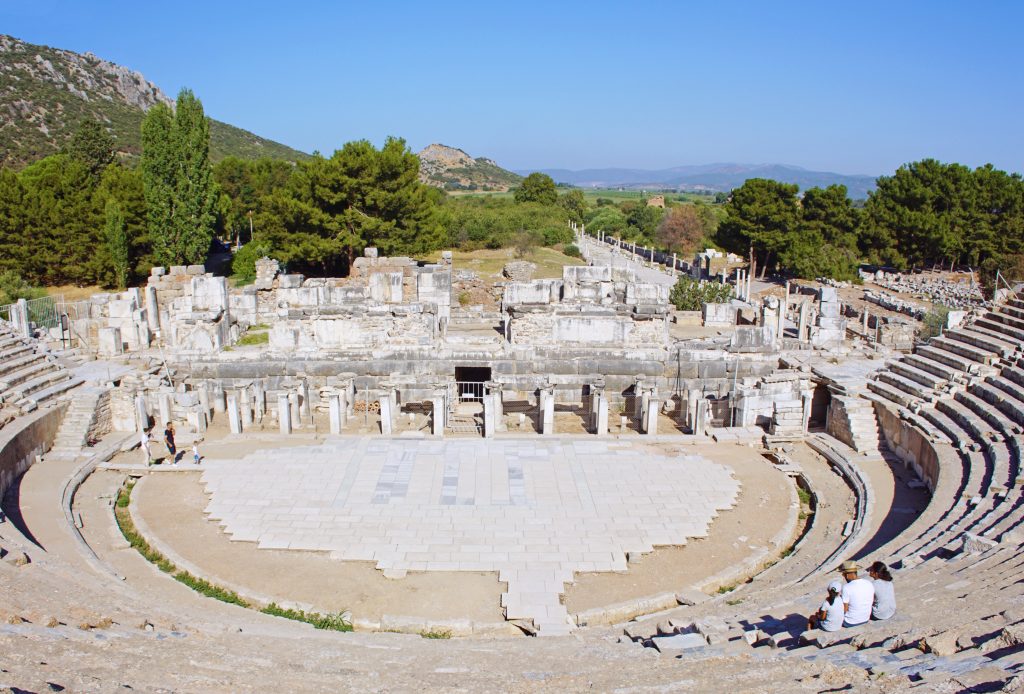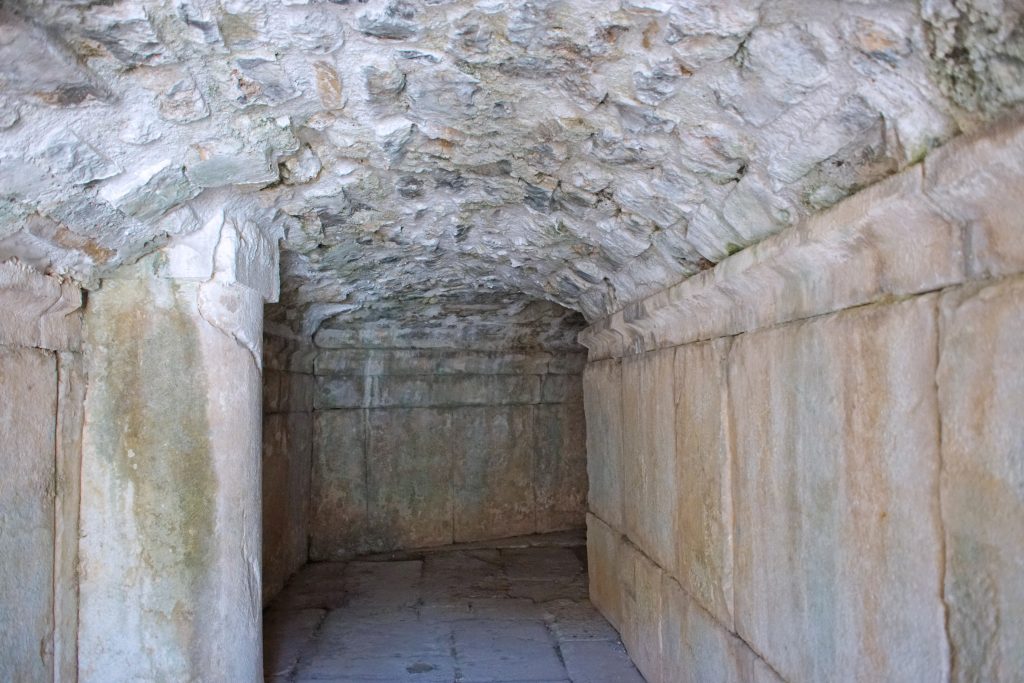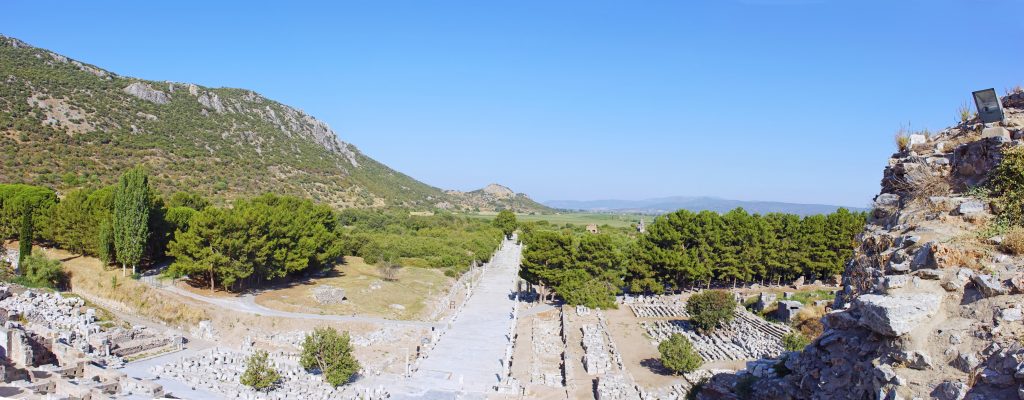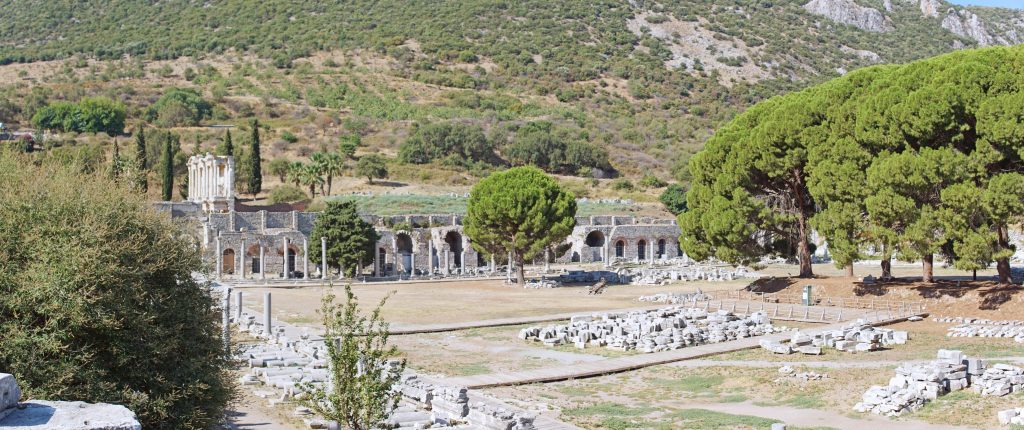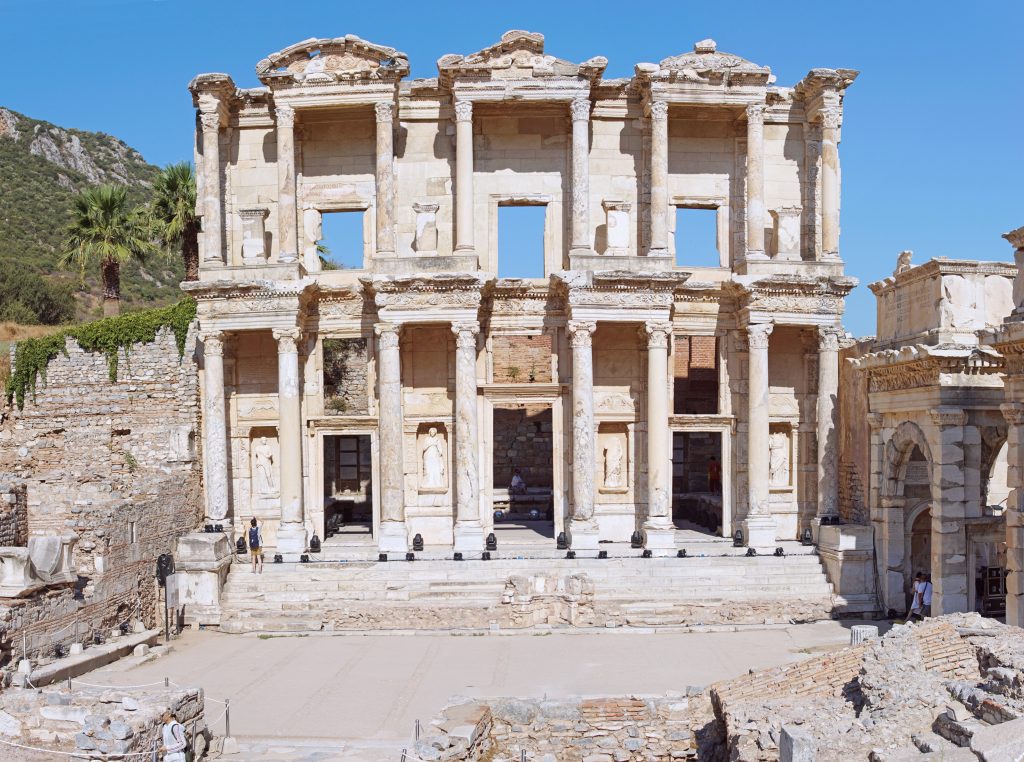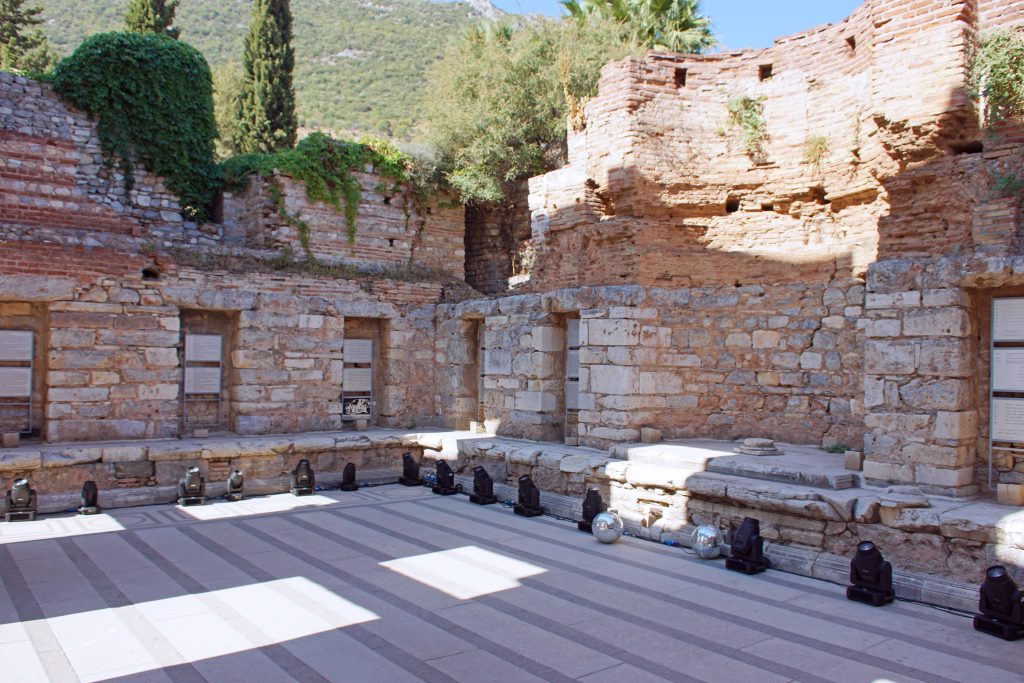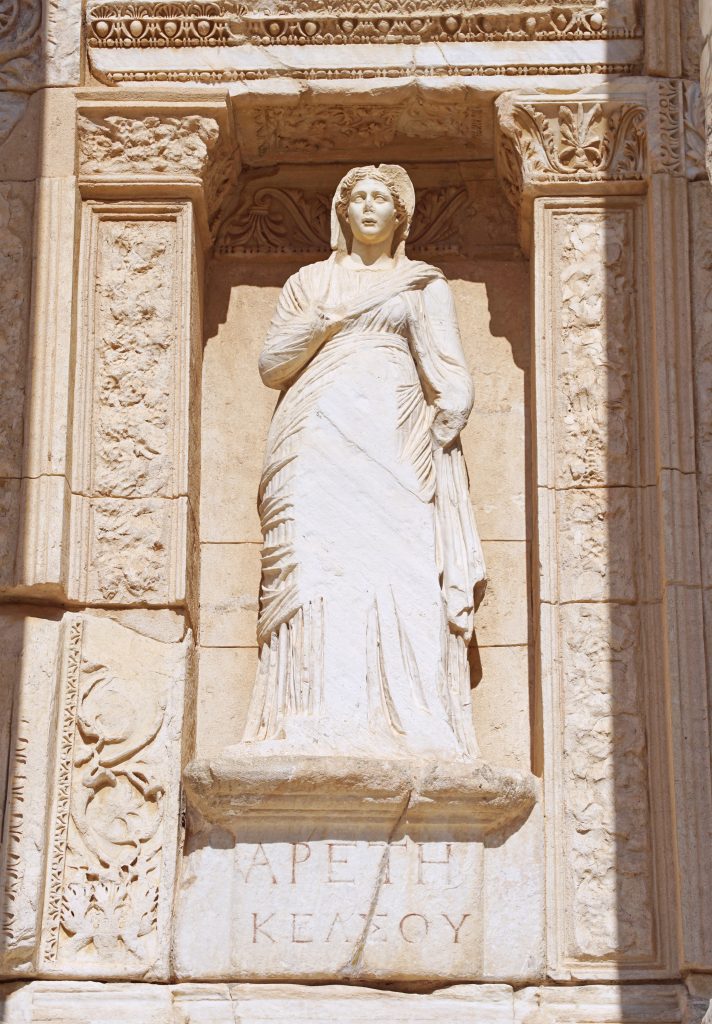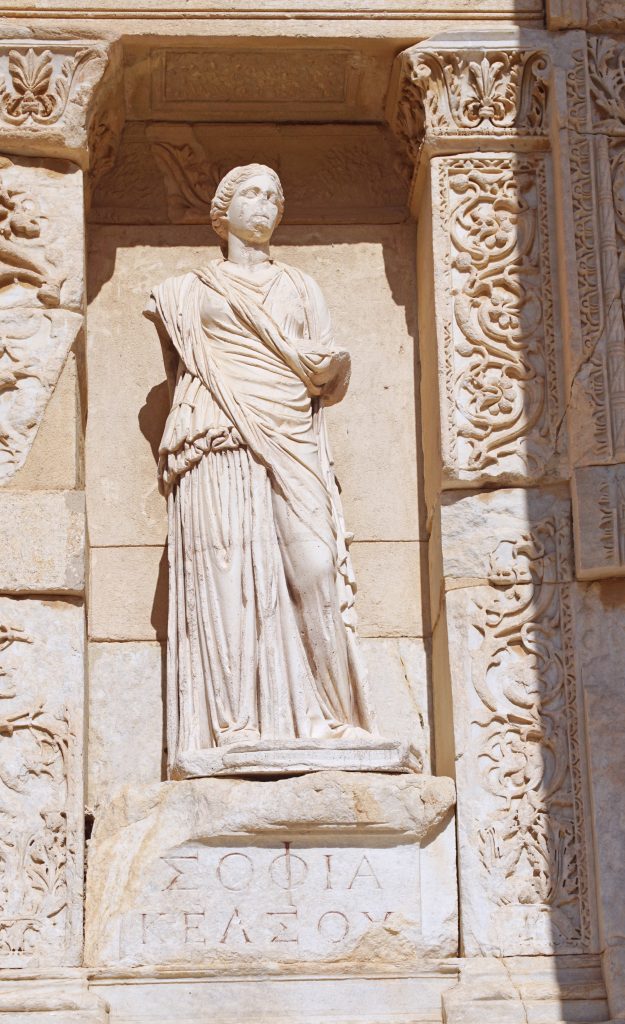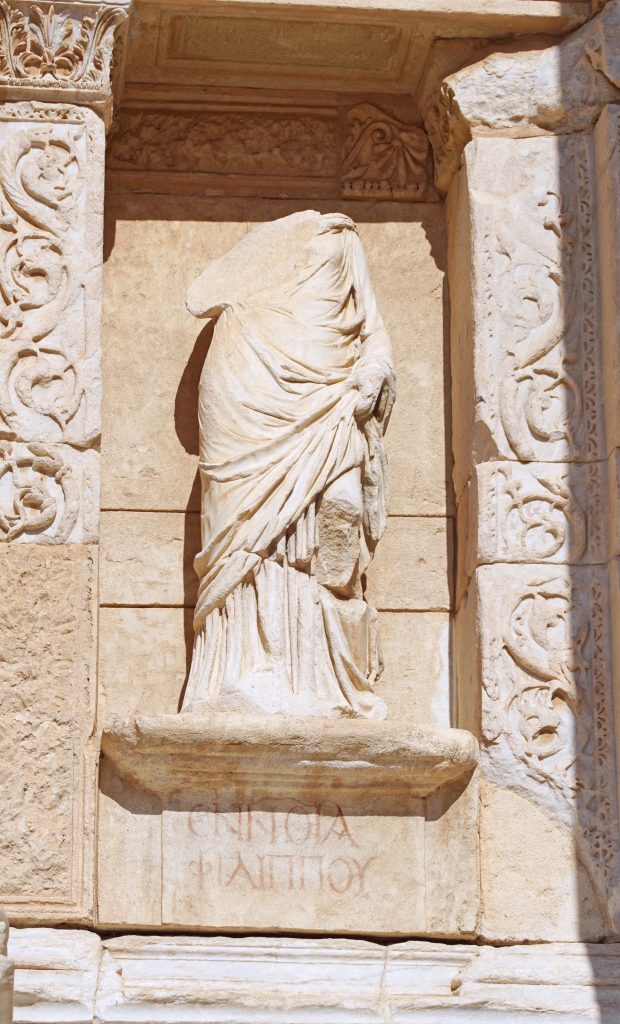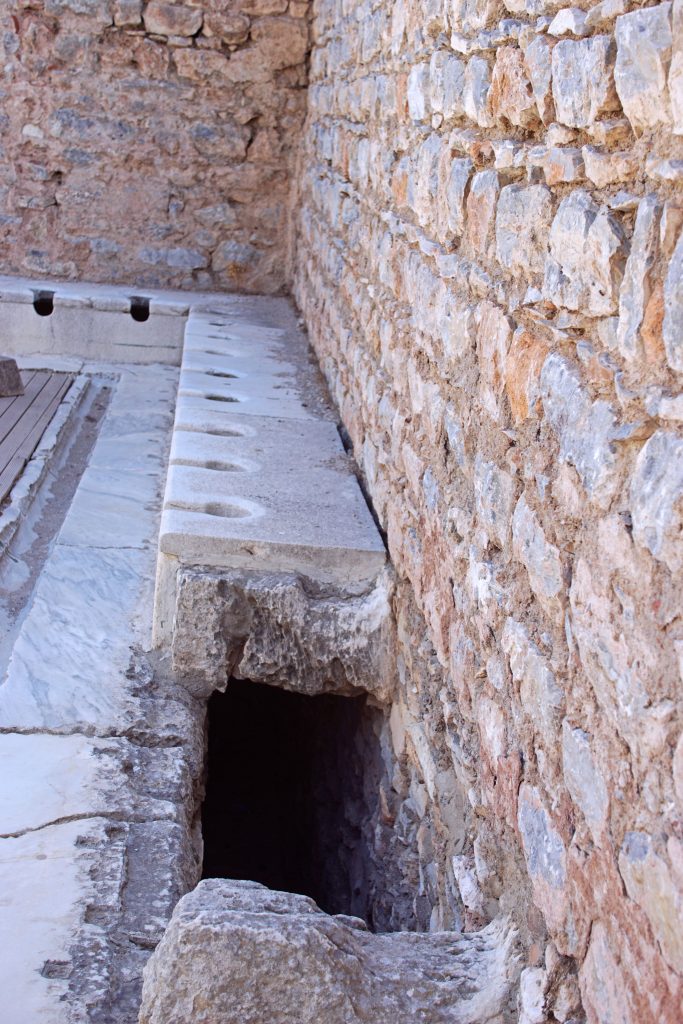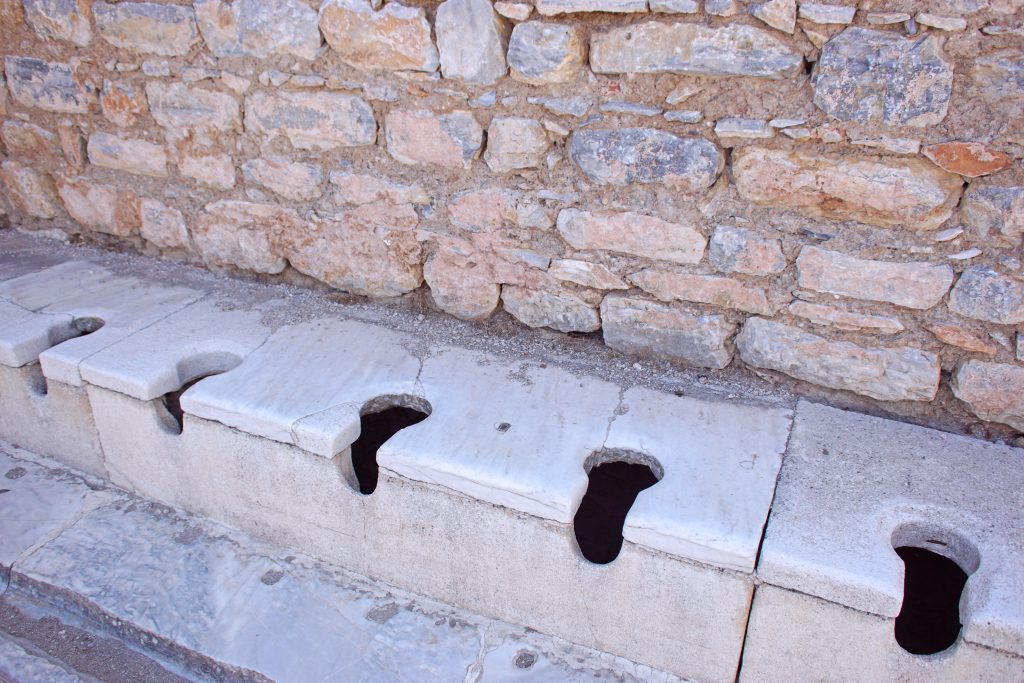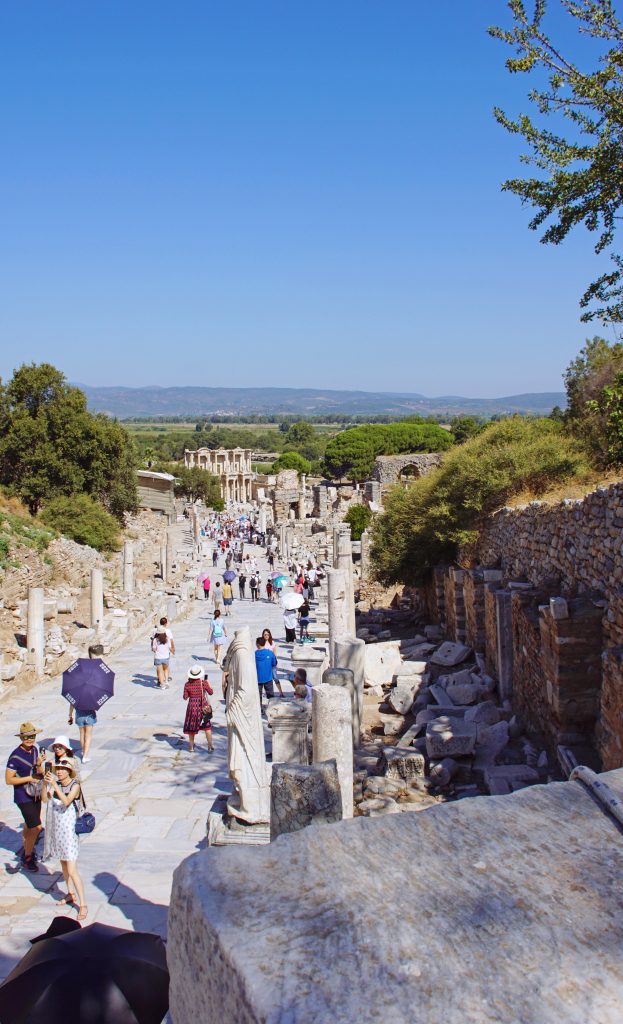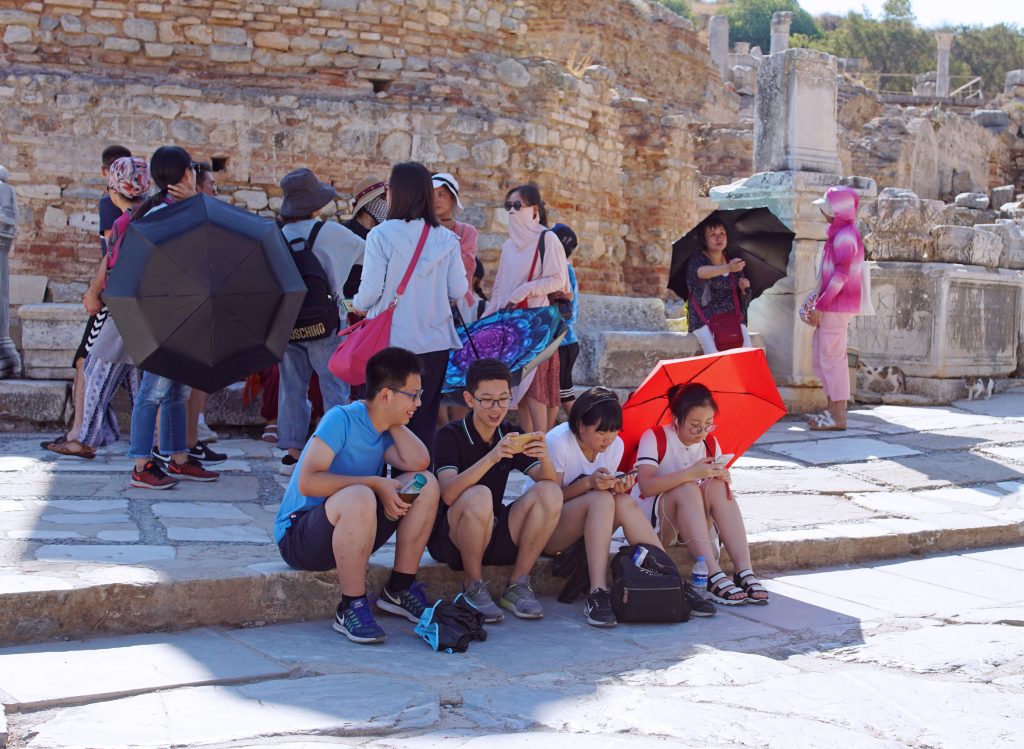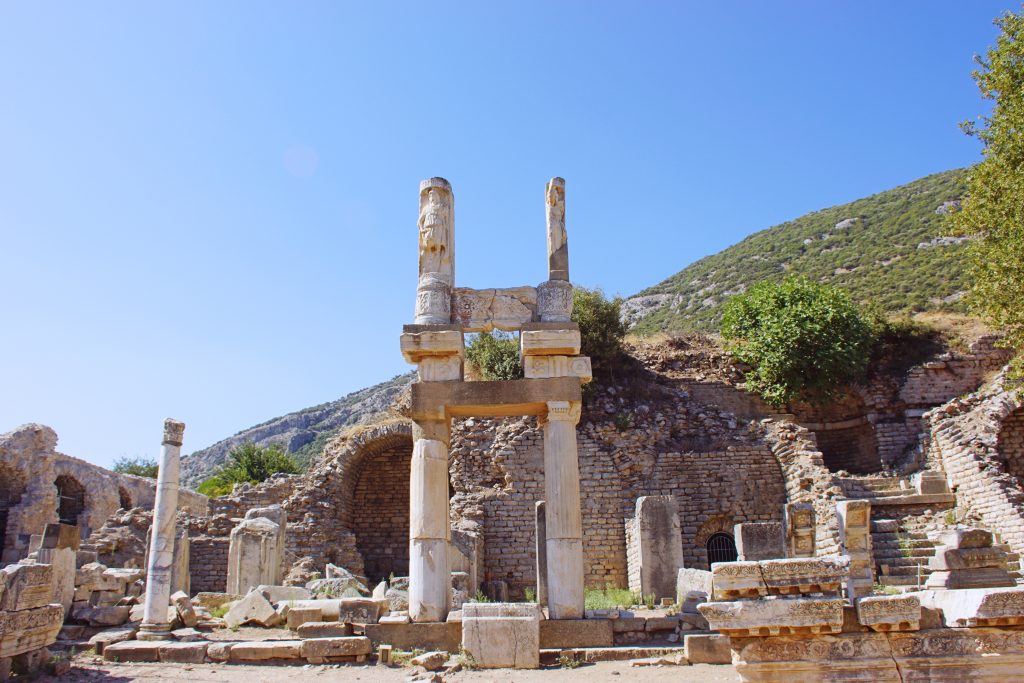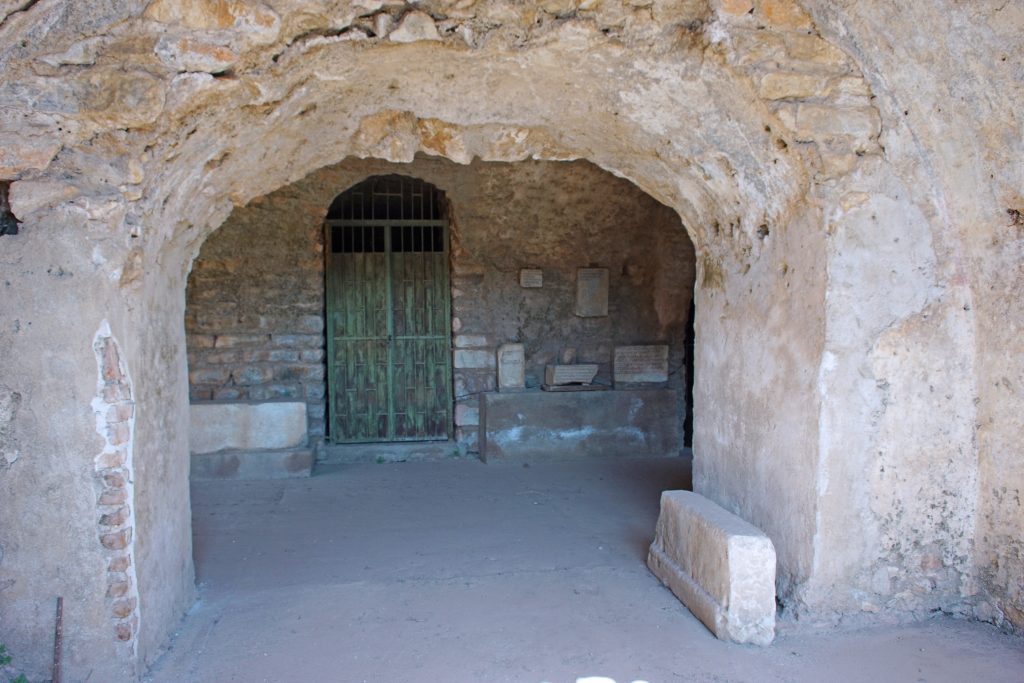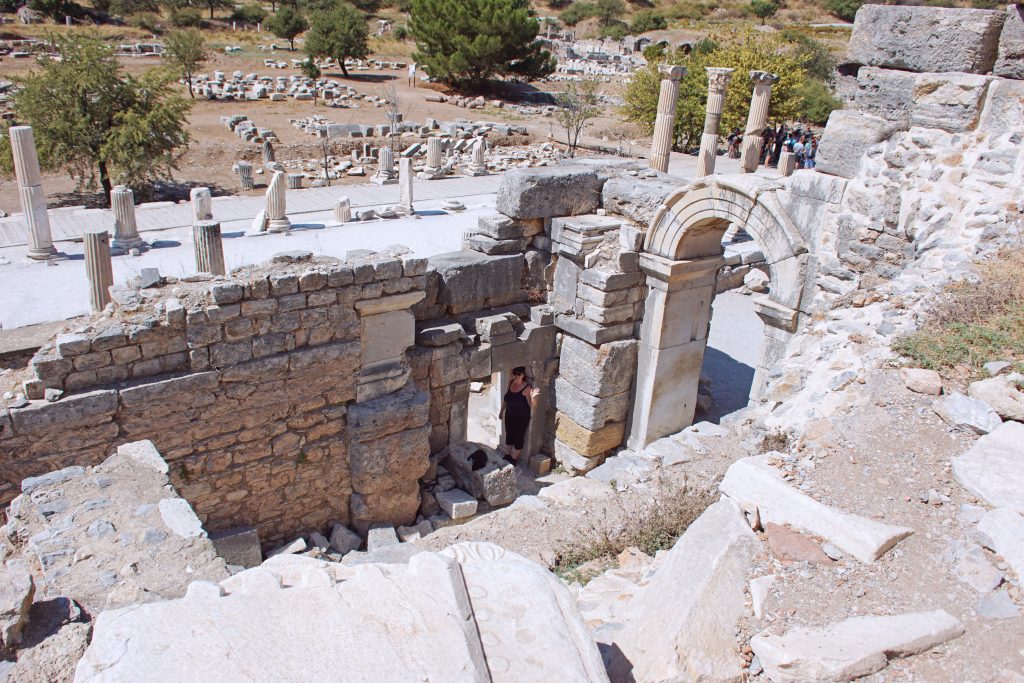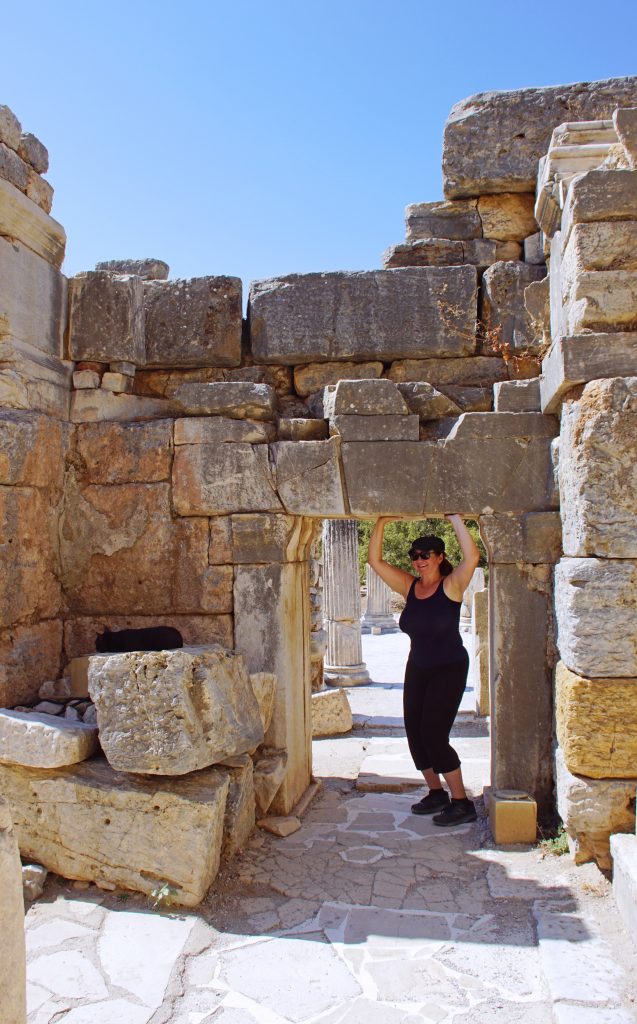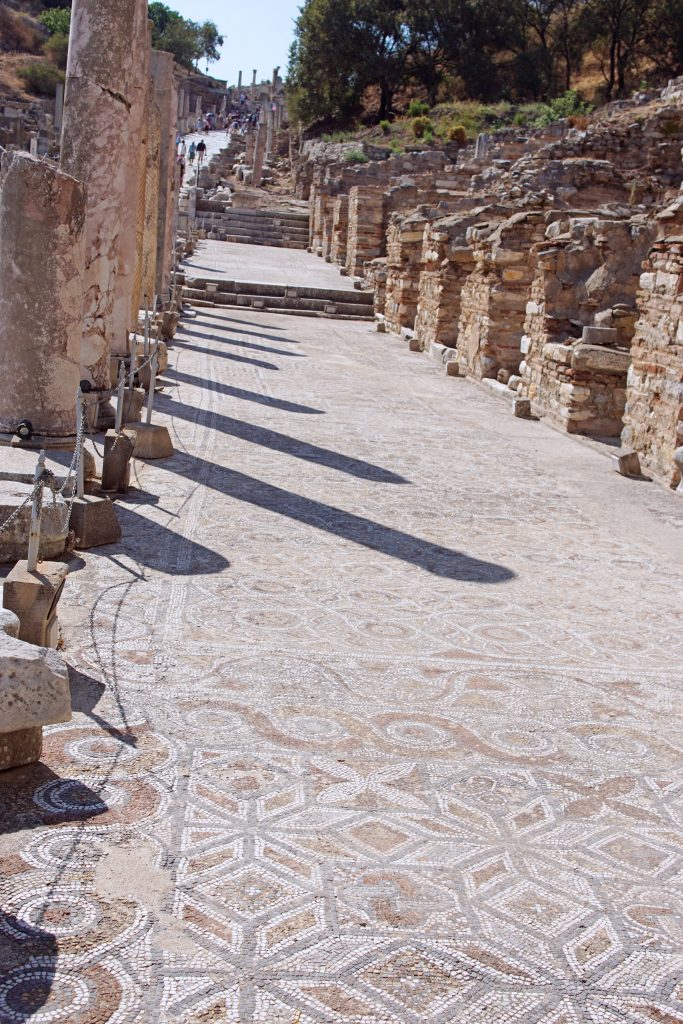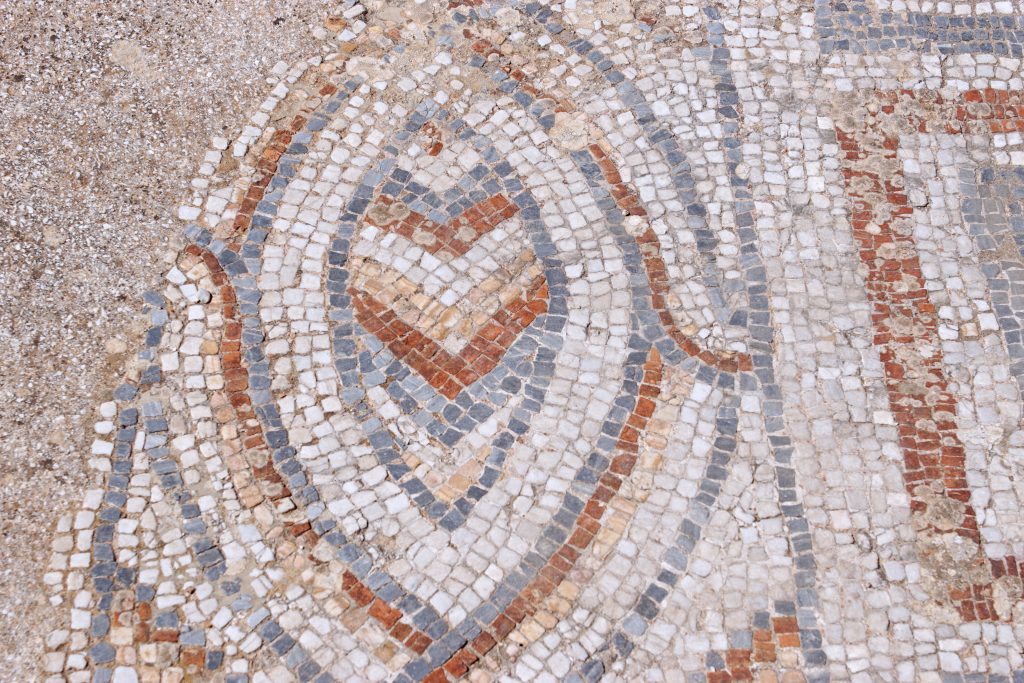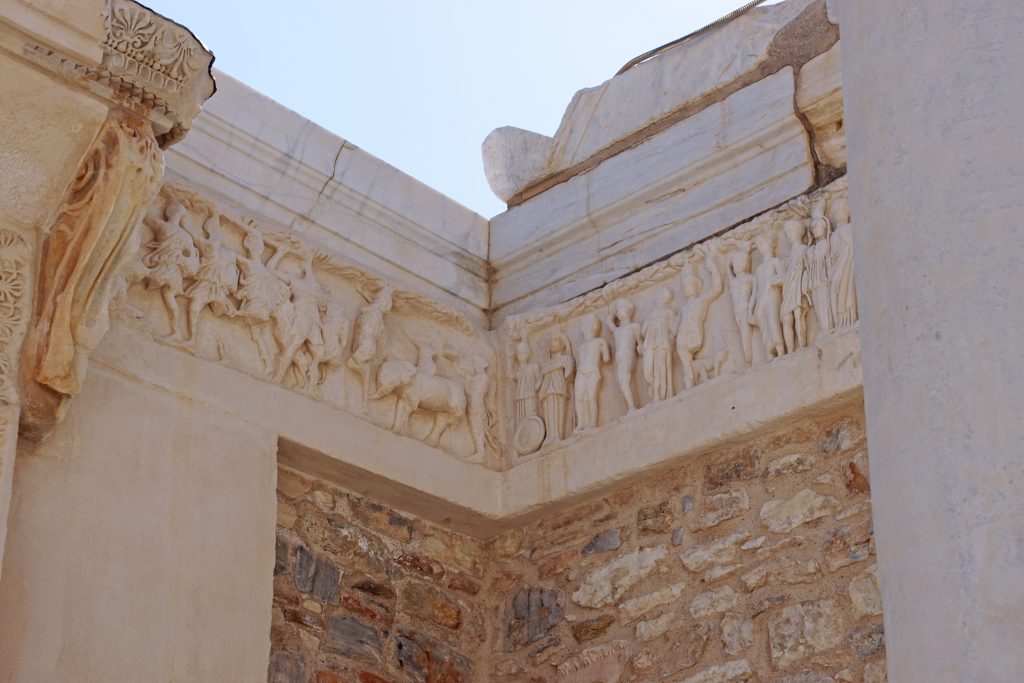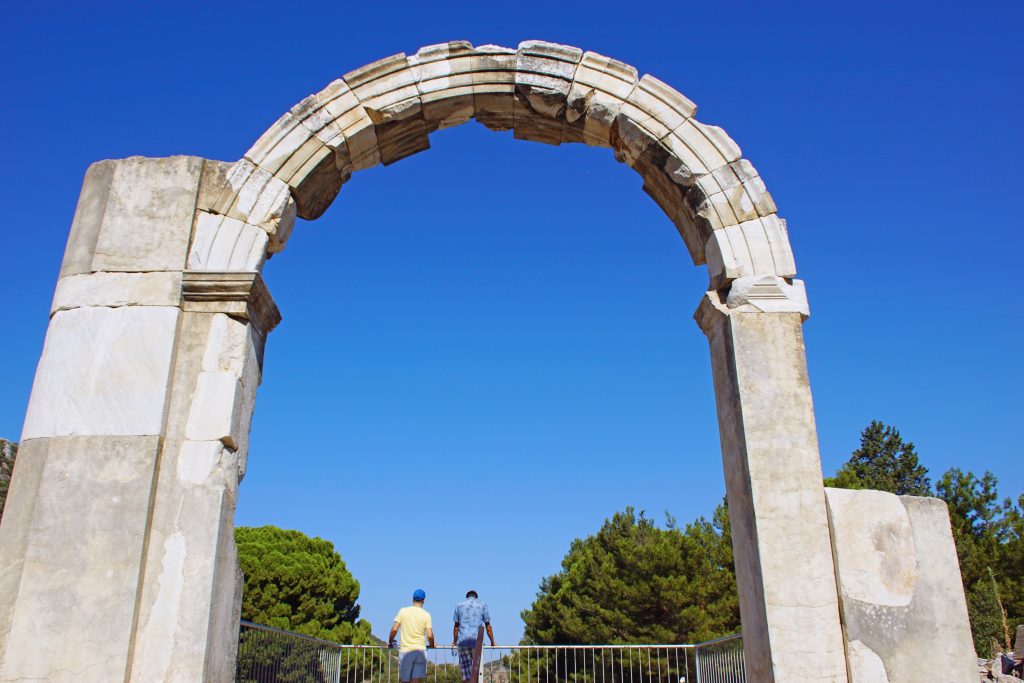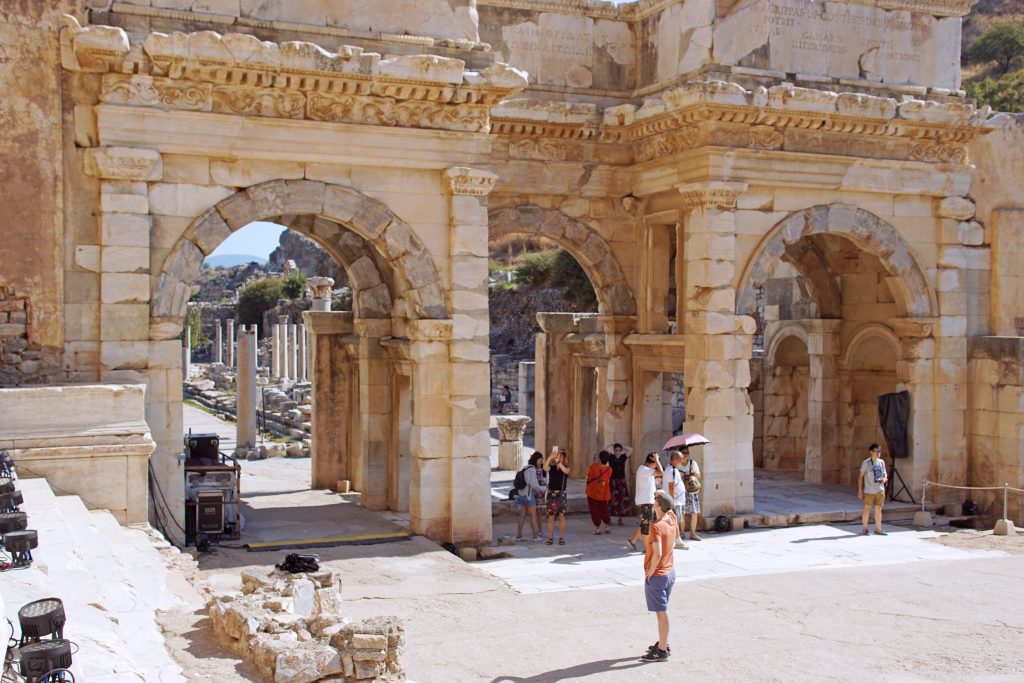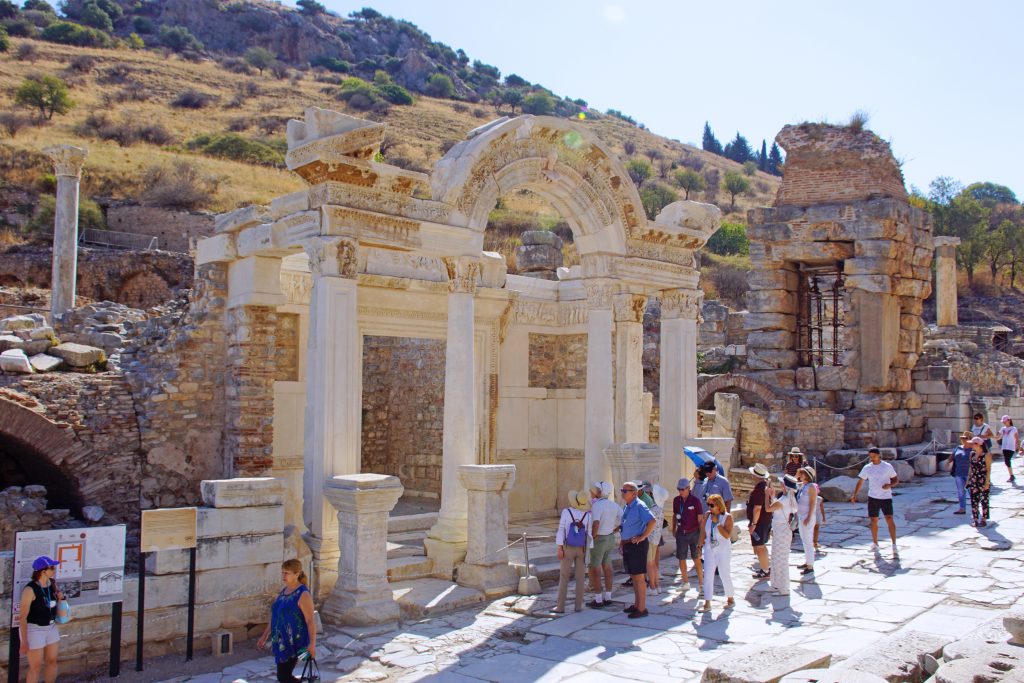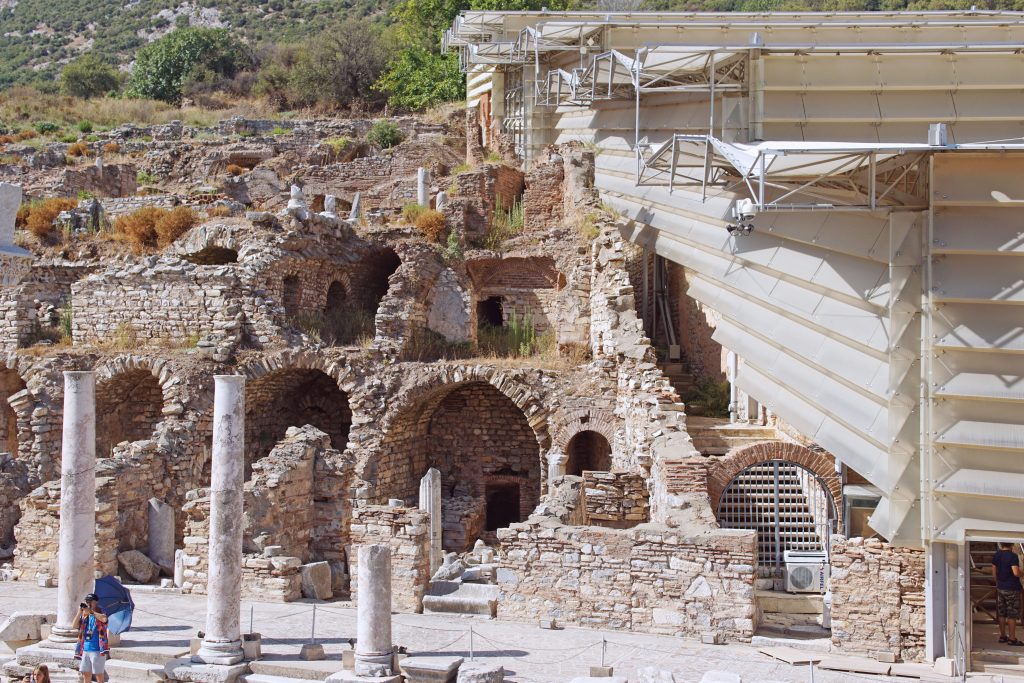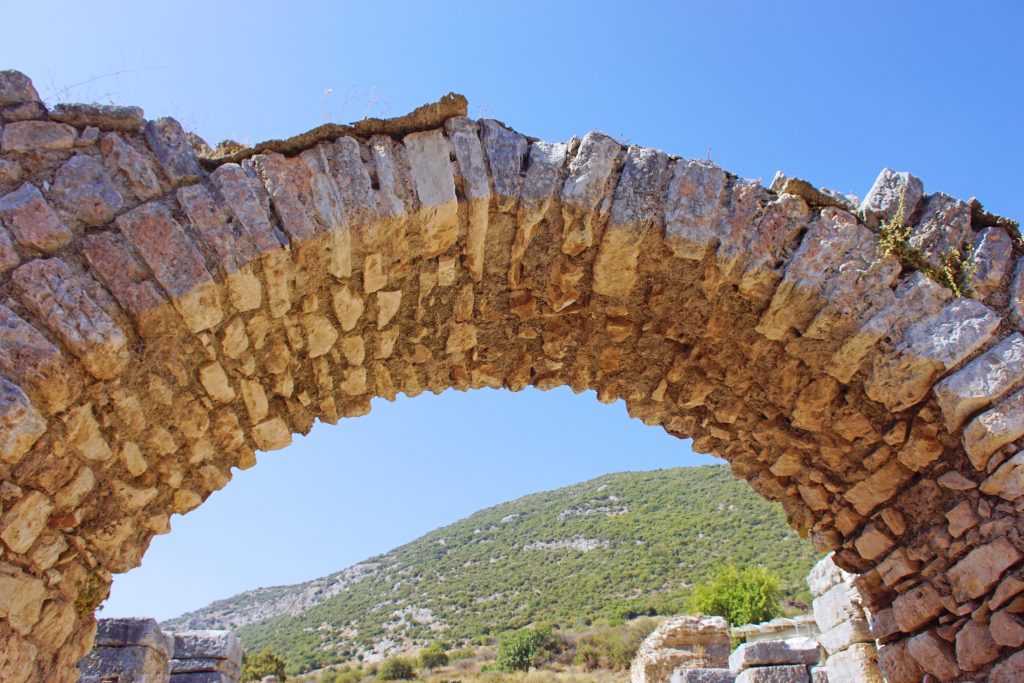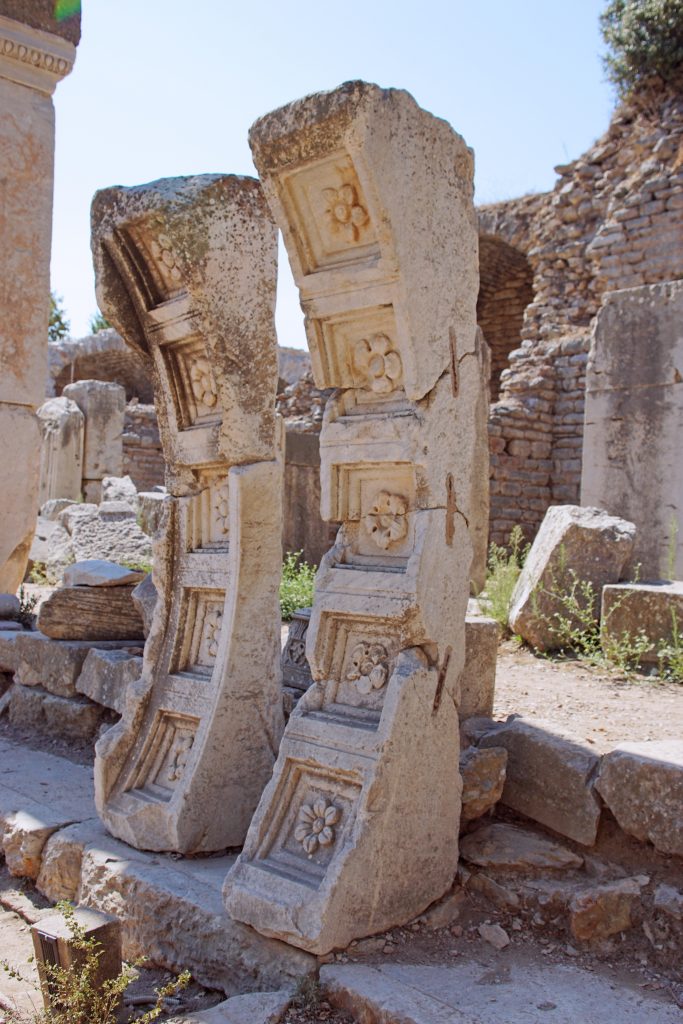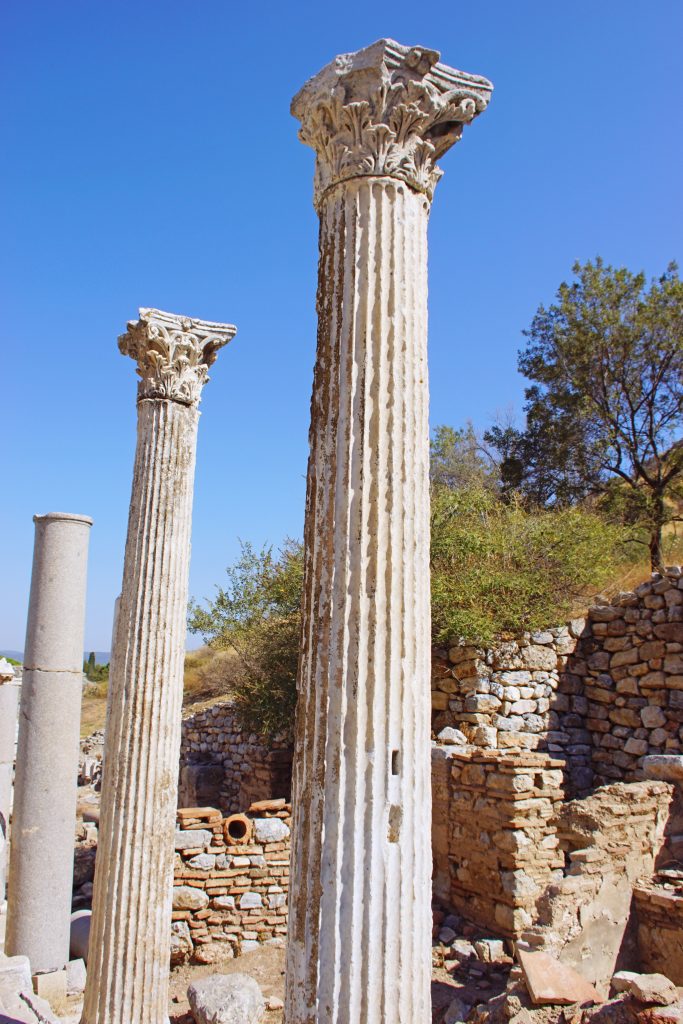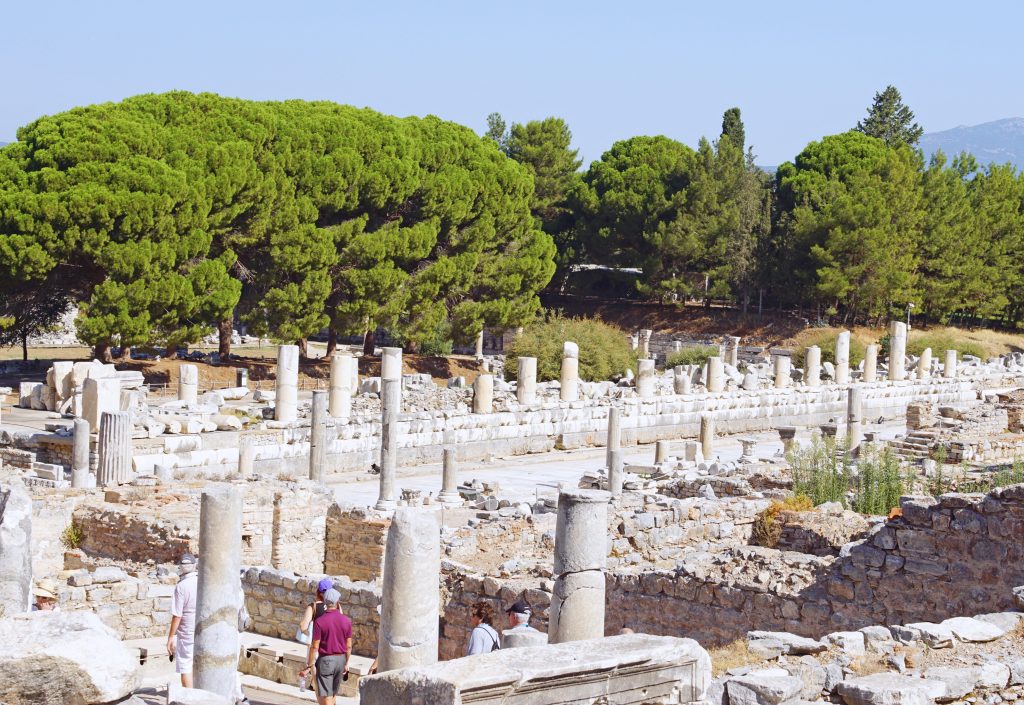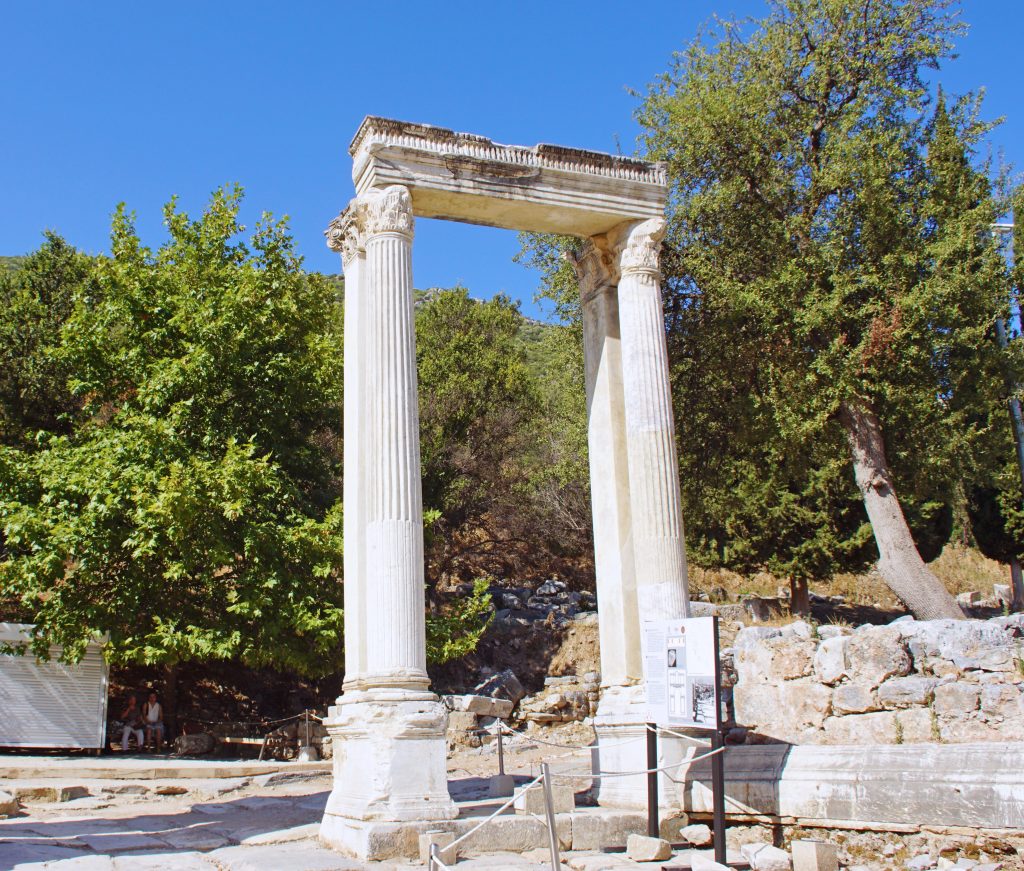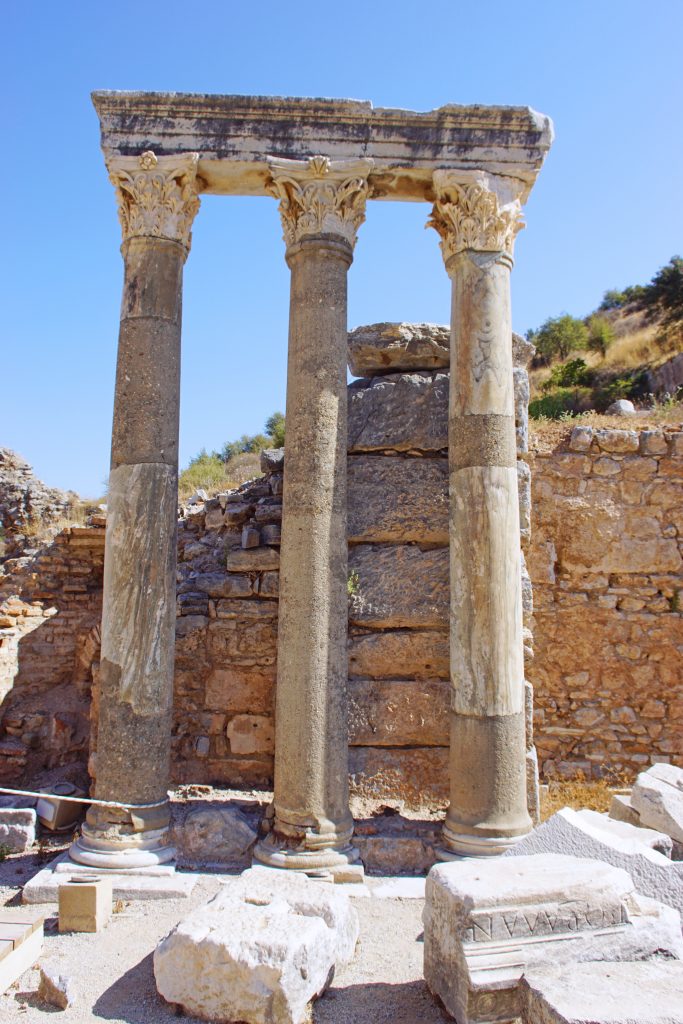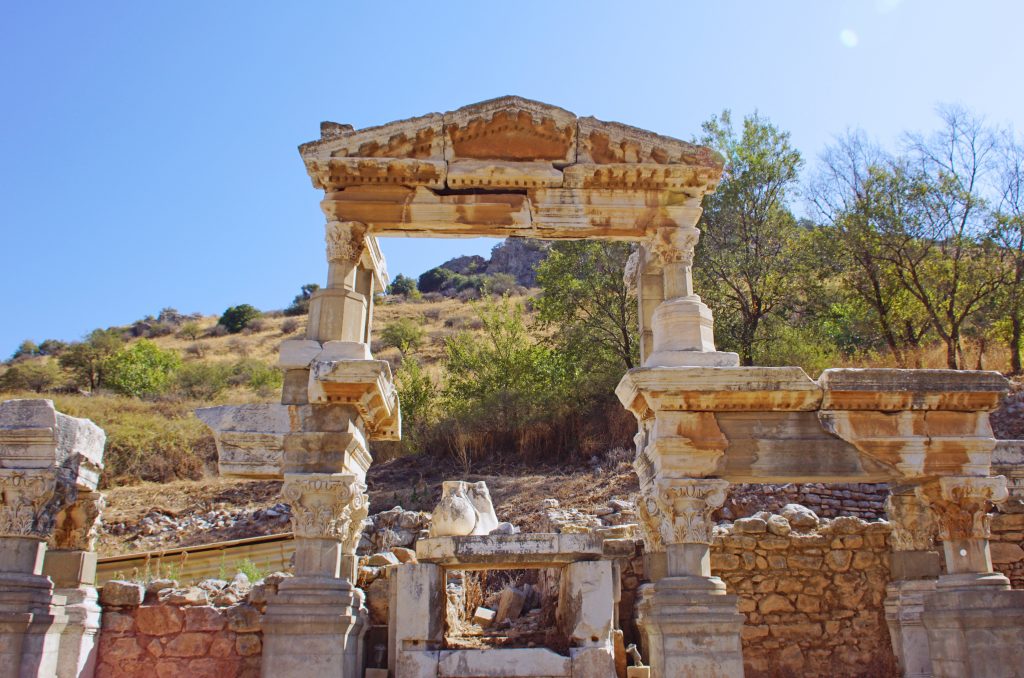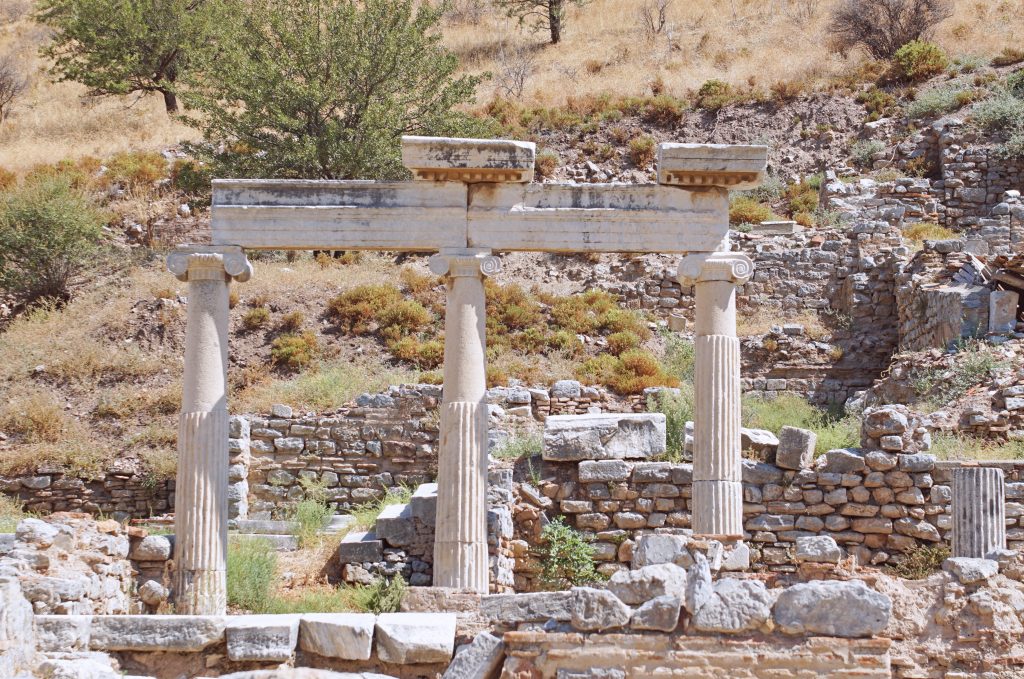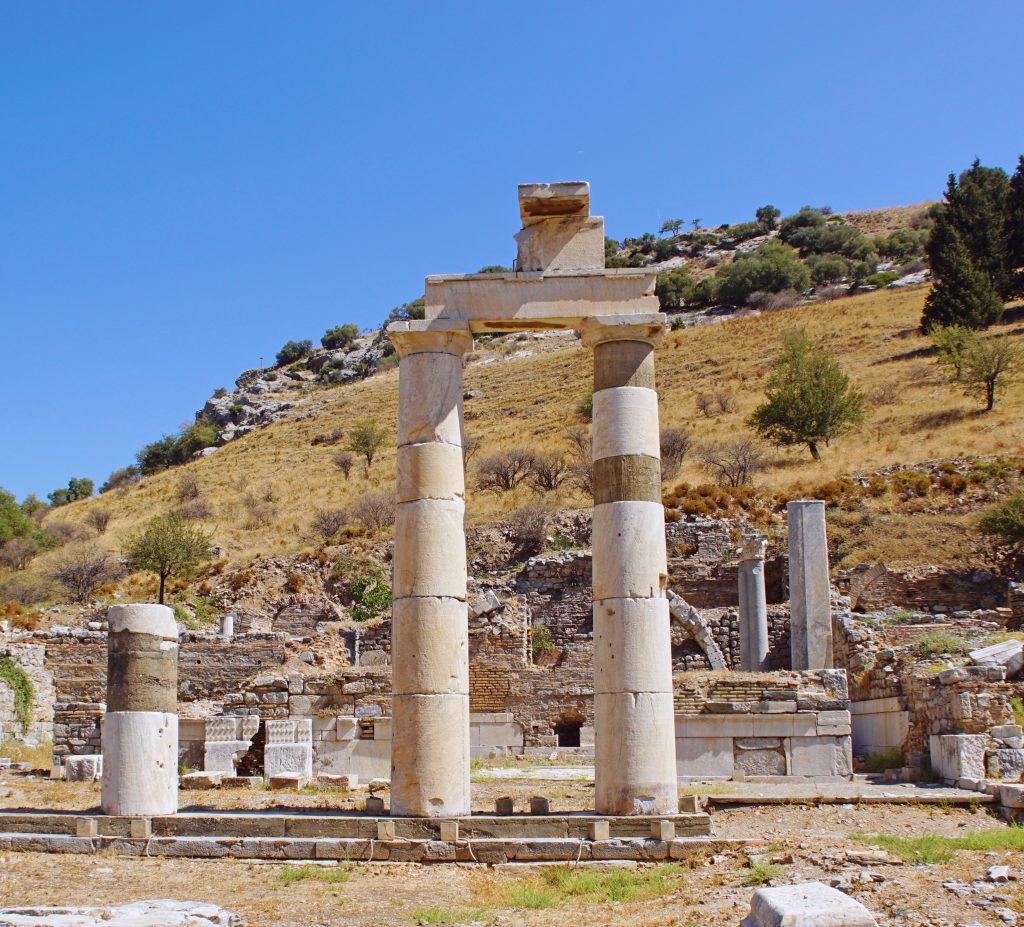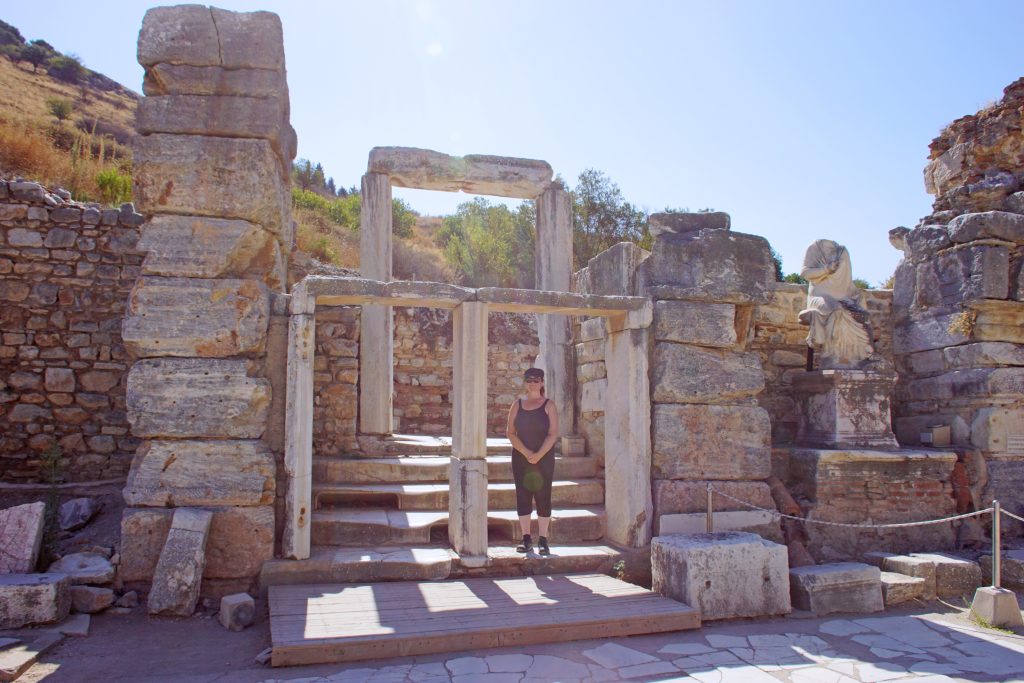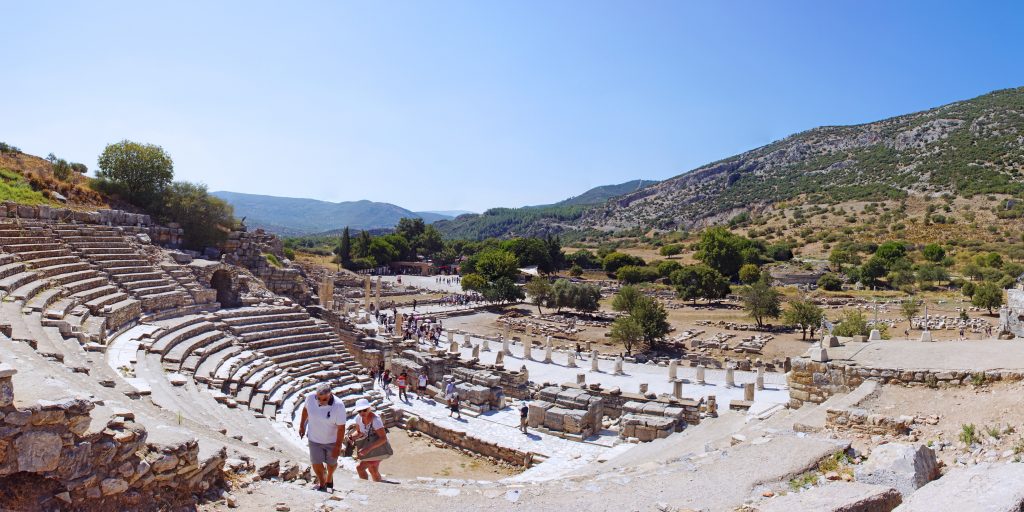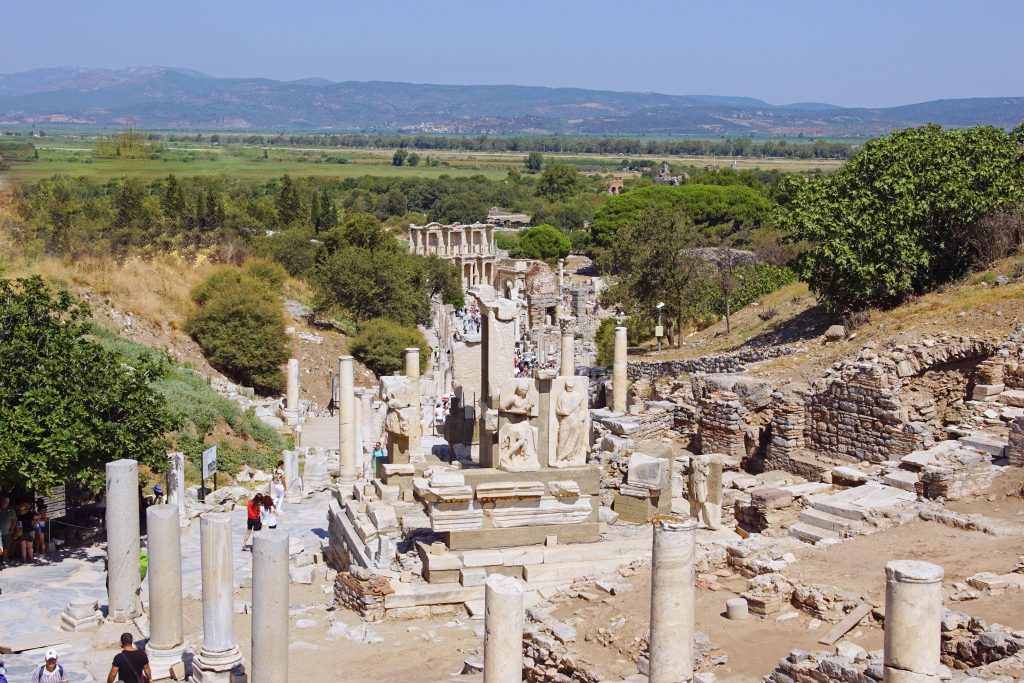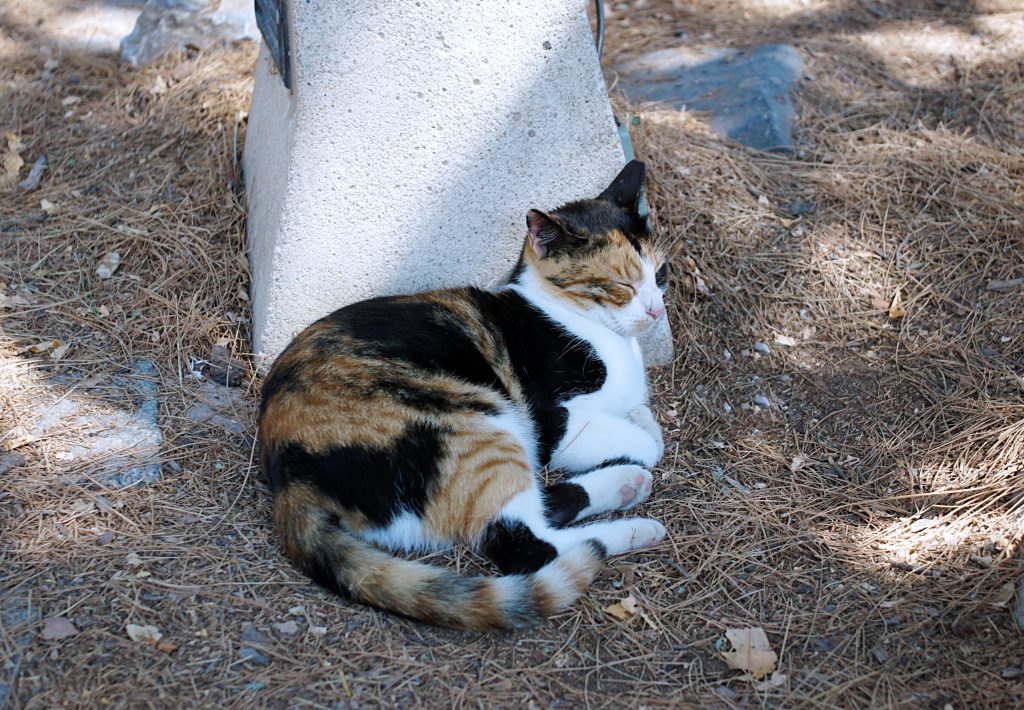About 3,000 years ago, a group of Attic and Ionian Greeks colonists displaced the native Carian and Lelegian inhabitants of an area near the Küçükmenderes River in western Turkey and founded Ephesus, a city famous for many monumental buildings including the Library of Celsus and a theatre capable of holding 25,000 spectators. It is visited annually by about 1,500,000 tourists, and today that includes us.
Ephesus has an entry point on the top of a hill and another on the bottom. The top serves many tourist busses which arrive shortly after the ruins open. Naturally, we enter from the bottom just upon opening. 😎
The Great Theatre of Ephesus
Walking from the entrance, we pass pieces of marble and stone, then round a corner and are greeted with a panoramic view of the Great Theatre of Ephesus.
The Great Theatre, on the foot of Panayir mountain, originated during the Hellenistic period (third to first century BC), then was rebuilt in the first century AD with a two-layered three-storeyed façade. The theatre hosted performances, assemblies and, in the Roman Imperial period, gladiatorial contests. Even in ruins, the theatre inspires awe. Note that the path at the very bottom of this photograph is of modern design, while the large marble road still maintains the original stones.
We climb the steps to view the theatre and the countryside. Note that when the city of Ephesus was built, the land was far more lush. Centuries of over-grazing by goats has led to the shrubbery-appearance shown here; this is true for many parts of Turkey and Greece, particularly on islands.
We sit for a while and imagine. Did the performers move about the stage, speaking to the audience like a Vaudeville act, or did they interact only with each other, never breaking the fourth wall? The square columns supported a ceiling; was it also used as a place to display props and background screens? Did the performers enter from the center opening to the applause of 25,000 fans? Was the area behind the stage full of artisan’s shops, painted brightly? Were performances ever given at night, under the light of a full moon or perhaps hundreds of candles?
Here we see what the performers saw. We imagine the seats were brightly painted, and perhaps banners flew along the top. Notice the room on the far right. We are not allowed inside, but we guess it led to the green room.
There is a grate covering the entrance, so I put my camera through and use the flash to get a good photograph. It seems kind of spooky, like something you’d need a torch to explore—but I suspect, when it was used, it was gaily decorated and well-lighted.
According to the internet: Arcadian Street is situated between the Harbour Baths and the Great Theatre. It was constructed in the Hellenistic Period, but then was restored during the reign of the Emperor Arcadius, from whom it takes its present name. The street was 530 meters long and 11 meters wide, and on both sides of the street there were shops and galleries, and gates in the form of monumental arches. There were four higher columns with the statues of four apostles on the top. It was one of the three lighted street at that time along with Rome and Antioch. Fifty streetlights lit up its colonnades and water and sewerage channels ran beneath the marble flagstones.
Commercial Agora
Leaving the Great Theatre, we follow Marble Street towards the library (the two-story structure on the left). To our right is the Commercial Agora. The internet has this to say about it: The Commercial Agora is one of the two Agoras located in Ephesus with a size of 11,000 square meters. It was built in the Hellenistic period and open only one day each week, then enlarged in the Roman period and was open every day. It was very close to the port and there was a direct connection to Arcadian Street. There were columned galleries and shops on all sides and the floor was paved with mosaics. The center of the Agora was uncovered and paved with marble slabs.
The Celsus Library
The Library of Celsus was built in honor of the Roman Senator Tiberius Julius Celsus Polemaeanus, completed between 114–117 AD by Celsus’ son, Gaius Julius Aquila. The library was built to store 12,000 scrolls and to serve as a mausoleum for Celsus, who is buried in a crypt beneath the library in a decorated marble sarcophagus. The interior of the library was destroyed, supposedly by an earthquake in 262 AD (though other evidence points to a fire during a Gothic invasion in that same year) and the façade by another earthquake in the tenth or eleventh century AD. It lay in ruins for centuries, until the façade was re-erected by archaeologists between 1970 and 1978.
The inside of the library is somewhat less than we expected. Oh, well. ¯\_(ツ)_/¯
One of the statues that graces the Library is that of Arete; the idea of excellence was ultimately bound up with the notion of the fulfillment of purpose or function: the act of living up to one’s full potential.
Another statue is that of Sophia, encouraging wisdom.
The Goddess Ennoia reminds us of the importance of thoughts and ideas.
At this point, Ephesus begins to get crowded. In my journal, I write the following: We arrive early, and from the amphitheater to the library, we are basically alone. At the library we look up the hill and see…the approaching hordes! Orientials, massed for attack, their selfie sticks glistening in the morning sun, armed with phones containing the worst cameras made. The wedged in to nooks and crannies, selfie sticks extended, smiling and extending two fingers in what used to be a peace sign, apparently unaware of the vast marvel of these ruins. We allow them their adventure without bias, knowing we were once like them, and hoping that, perhaps one day, they will review their photographs and be inspired to discover the rich history of this time and place.
The Latrines
The latrines were part of the Scholastica Baths and built in the first century AD. They were the public toilets of the city and, according to the internet, there was an entrance fee to use them. However, a sign near the latrines states that they were free of charge.
One wonders how ancient peoples can be so enlightened about the natural function of defecation, while modern folks are embarrassed about simple flatulence.
Notice how close each opening is to the other. Perhaps this was a social place, no different than a restaurant.
Curetes Steet is one of the main thoroughfares in Ephesus, running from the Gates of Hercules to the Library of Celsus. Although it may seem a bit bleak, but at one time, 225,000 people lived here. The hillsides on both sides were crowded with vendor’s shops and houses of the wealthy, the distant plain was filled with houses and farms.
We hope they are taking a moment to describe the awe surrounding them, and not just checking their Facebook page. 😐
Domitian Temple
The Domitian Temple must have been a magnificent sight. According the to the internet: The temple was dedicated to the Roman Emperor Domitian, who was the first Emperor who allowed Ephesians to erect such monuments. The Temple was constructed on the second floor of a terrace at Domitian Square and consisted of thirteen columns at the long sides and eight columns at the short sides. There were another four columns in front of the cella. The ground floor of the building contained warehouses and shops. Even though, initially, it was believed that the Emperor honored with that temple was Domitian, according to recent research in ancient Ephesus, it was erected for the Emperor Titus.
There are many interior areas where we are not permitted to visit. I put my camera through the grating and use the flash to give an idea of what it might have been like. I suspect the metal door is of recent design, and a wooden door would be more in keeping with actual usage.
We can easily understand why archeologists always want to dig: Under the marble pavement of the street existed living spaces.
The dark blob on the left is a cat, completely ignoring us.
Still preserved in Ephesus is the mosaic sidewalk on front of the Terrace houses, occupied by wealthy Ephesians between the first and seventh century AD.
Modern tiles this size are glued to a mesh backing; these tiles were each placed by hand. I assume there was a special substrate acting as a barrier between the tile and the underlying soil.
One of the many building decorations seems to be of a person riding a small elephant. I guess we’ll never know what that is about. 😯
Arches
We find a number of interesting arches in Ephesus.
The Commercial Agora was blocked all along Marble Street, so special passages needed to be constructed. The columns next to the arch indicate there is more to this than just an arch, but that’s lost to antiquity. Note that the arches are not quite as tall as they appear.
Gate of Mazeus and Mithridates was built by two slaves in order to pay honors to Augustus and his family because he had set them free. It was used as the south gate of the Commercial Agora, and was 16 meters tall. (Note that this seems excessive; the gate would have been as tall as a five-story building.)
The arches of Hadrian’s Temple, built in the second century AD. If you zoom in, you can see the fine detail of the frieze, including the bust of Tyche.
Arches of structures that are not temples or dedicated to high officials have arches made of common stone and mud. We assume it was covered with stucco and decorated in bright colors.
We can see that there are many arches made of simple material found locally, which must have been much less expensive than importing marble.
Concrete was first used in the fourth century BC, and extensively used by the Romans during their Era of Empire. This arch appears to be made of concrete; lack of reinforcing steel limited the tensile strength.
Columns
Columns have always perplexed us. Why are they round in cross-section? It would be much easier to make a square column (and square columns do exist, so why go through the trouble of making them round?
Besides making these Corinthian columns round, grooves (fluting) were cut into them for the sole purpose of making them look rounder. According to the internet: After a little early experimentation, the number of hollow flutes in the shaft settled at 24. This standardization kept the fluting in a familiar proportion to the diameter of the column at any scale, even when the height of the column was exaggerated. Roman fluting leaves a little of the column surface between each hollow; Greek fluting runs out to a knife edge that was easily scarred.
What did this really look like 2,000 years ago? Did these columns support massive arches, or perhaps a second story of shops? That is a LOT of marble to excavate, carve, transport, and construct.
Although aesthetically pleasing, arches were probably difficult to construct as compared to simply laying a slab of marble on a pair of columns.
Egyptians, Greeks, and Romans were excellent engineers, so we assume they were very knowledgeable in the proper placement of columns to support the roof.
Trajan’s Fountain had widely-spaced columns supporting the stones over the entrance. The stones have cracked, yet (apparently) they are held in place because they can’t slip; we can see that an arch would have better served such a wide space.
Note the volutes (scrolls) of the column’s capital, a clear indication they are Ionic. Notice, too, that these column as spaced much farther apart than others shown above.
It is obvious that the brown part of the column is concrete, but the rest of the columns of the Prytaneion (displaying the List of Curetes) look as if they were put together from individual pieces. We don’t know if this was a common method of building columns, or if it is done here only for representational purposes.
Perhaps this is more illustrative of columns not found in temples or the houses of the wealthy: square columns with small, flat stones overhead. It seems to be an economical solution when building with stone.
The Glory of Ephesus
When visiting ruins, we look around us and try to understand what it might have felt like to have lived in those days.
The street is lined with tall columns, perhaps supporting additional structures, perhaps lighted with lamps. Banners and colorful drapery adorn buildings. Thousands of people fill the streets, shopping, laughing, and basking in the wealth of the great city.
The Odeon, at the north end of Curetes Street, is a 1,400 seat theatre where concerts play and parliament meets. The stage is two stories tall, and there are vaulted gates leading to the cavea. A statue of the god Eros smiles on the performers. It is a more refined experience than the Great Theatre. In the distance, seemingly endless groves of olive trees cover the fields.
From the top of Curetes Street, the Memmius Monument is proudly displayed, just in front of Hercules Gate. Seeing the villages and farms in the distance, we realize we are living in the best of times. When has civilization ever reached such heights of grandeur and opulance? How could such splendor ever be surpassed?
The Cats of Ephesus
Yes, there are cats in Ephesus. But we didn’t want to ruin the adventure of imagining ancient times by multiple cat interruptions. However, if you travel to Ephesus, have no fear: there are cats aplenty.

